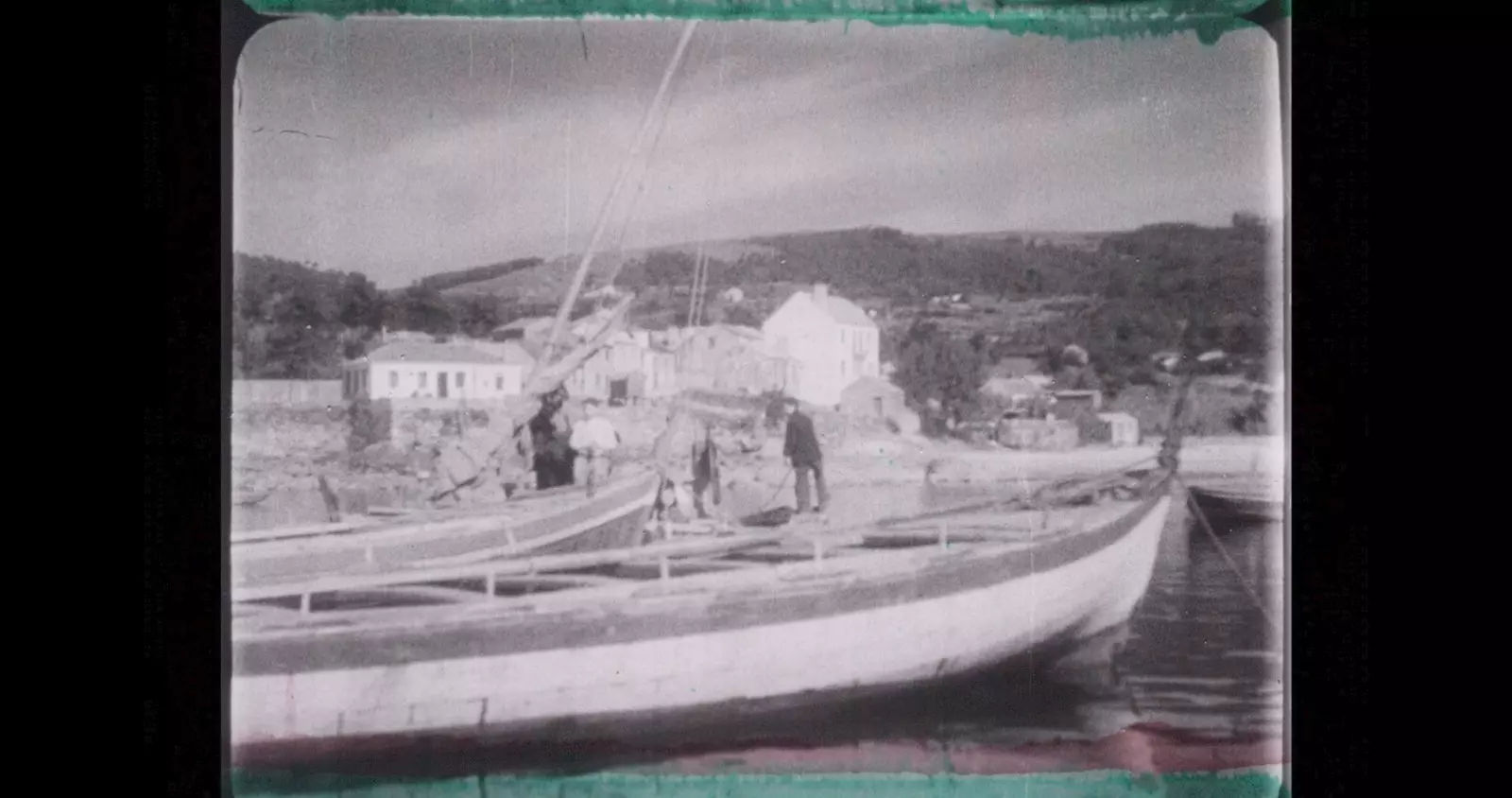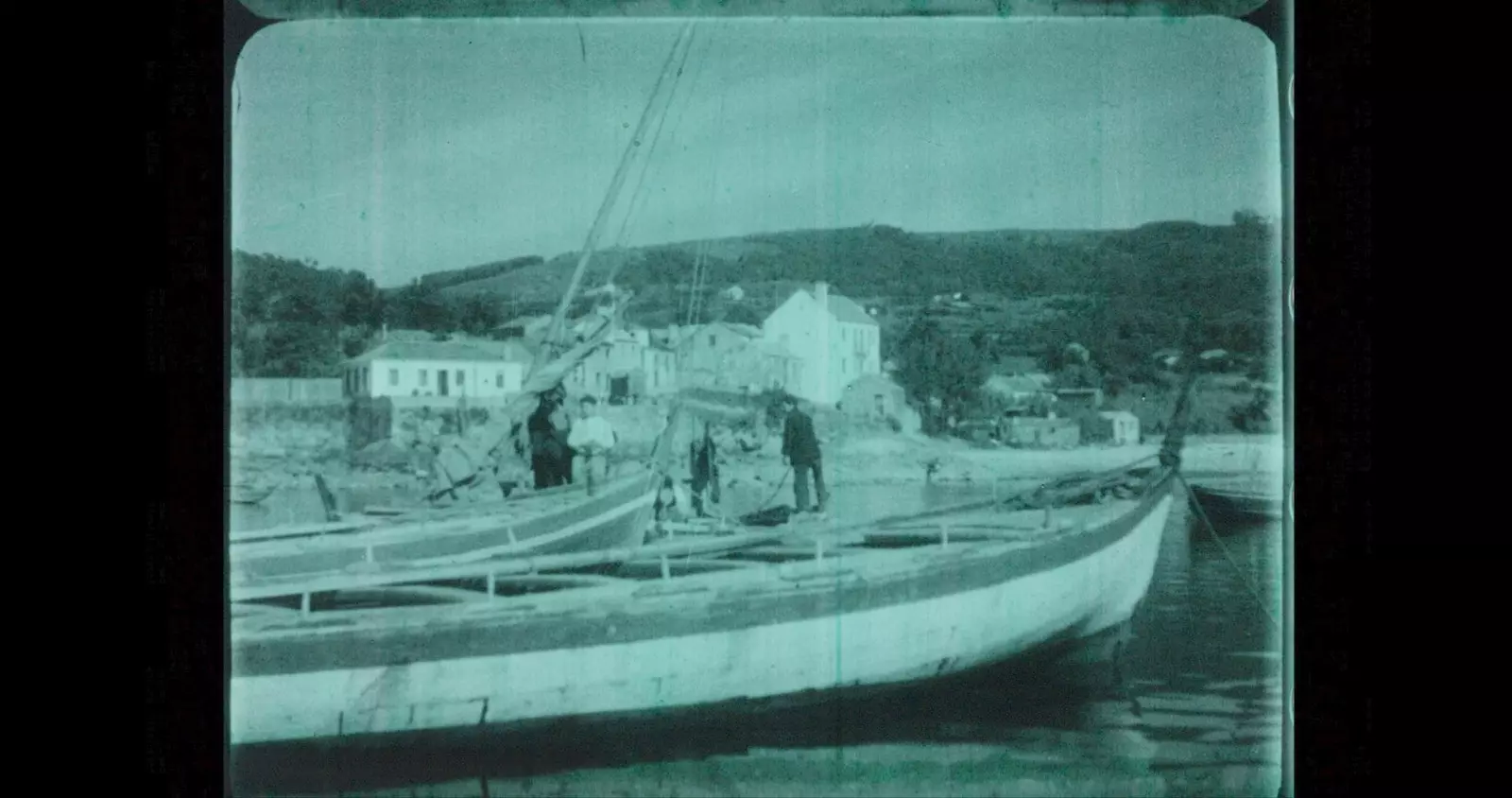Image resulting from the superimposition of the previous frame with the orange-red that continued
Almost a century after its premiere in 1927, The Spanish Film Library has recovered the original color of the first version of Pontevedra, the birthplace of Columbus, a short documentary film by the photographer, filmmaker and film researcher Enrique Barrero.
This is the first film shot in color in Spain thanks to an experimental system patented by Barreiro himself in 1925: the Chromacolor.
On October 1 we can see it at the Cine Doré and on October 29 it will be accessible online through Flores en la sombra, the Vimeo channel of Filmoteca Española. It will also be screened at the CGAI, the Galician film library, on October 27.

Original frame in the state in which it has reached our days, with traces of bluish green in its lower part
The importance of this title is that "It responds to the innovations introduced to obtain color cinema by Enrique Barreiro, and that possibility of enjoying color had not been achieved until now in Spain", highlights Marián del Egido, Director of the Conservation and Restoration Center of the Spanish Film Library (C.C.R.).
This recovery has been possible thanks to the collaboration between the Spanish Film Library and the Galician Center for Imaxe Arts-Filmoteca de Galicia, and it is part of a project that aims to bring together the materials that make up the Enrique Barreiro collection, deposited by his family in the Galician entity.
THE RECOVERY OF COLOR
Although the presence of color is not unusual in ancient materials, it was normal for the sequences, except in cases where they were painted by hand, to be dyed entirely in the same colour. The exceptionality of Pontevedra, birthplace of Columbus lies precisely in the system used: the Chromacolor.
The system Chromacolor it consisted of a rotating filter consisting of a red-orange part with a carmine-violet stripe and another yellow-green part with a blue stripe.

The frame after the color wash is restored
The response to these colors was captured in the negative in alternate frames, first when passing the image through the reddish filter and, in the next frame, when passing through the greenish filter.
After the film is revealed frames were dyed alternately carmine or red and green with blue hues, so that, when projected at high speed, the persistence of the retina was in charge of making the mixture and seeing the image in color.
When reviewing the material preserved in the Spanish Film Library, it was found that the colors appeared degraded due to the passage of time, because the red or carmine was practically non-existent and the bluish green had lost intensity.
A DIGITAL WORK BUT ALSO MANUAL
When carrying out the digitization, we proceeded to the restitution of the mentioned colors frame by frame, but when the tape was projected there was no mixing of colors. As Barreiro explained in his patents, The system did not give the desired results.
However, since the color information was available in the frames, the color could be recreated using another strategy: Manually overlay each pair of frames after the red and teal color is restored. In this way, the desired mixture was achieved and the consequent appearance of polychrome images.
Image resulting from the superimposition of the previous frame with the orange-red that continued
Javier Rellan , the person responsible for carrying out the project, explains that "once the problem of obtaining the color has been resolved, its recovery in the entirety of the footage has been a laborious process, since 20,000 of the 33,000 frames that make up the film had to be treated individually to a greater or lesser extent”
“Although the tools have been digital, the process still has a good part of craft work ”, adds Rellan.
Beyond the color recovery process, Marián del Egido highlights the previous research carried out to achieve the desired effect: “In order to recover the original color of the film, it has been necessary to investigate the scientific advances in optics in the preceding years”.
Furthermore, they had to “Find the way in which Barreiro transferred his own method of color cinema to his patents and recover the film as faithfully as possible with the help of current digital image processing procedures”, concludes Marián.
“Although the technique used to mix the colors is different, the final result is theoretically equivalent. This was the biggest difficulty: the change of strategy and getting the right shades”, concludes Javier Rellán.
PONTEVEDRA, CRADLE OF COLUMBUS
Enrique Barreiro was one of the most important figures of the 1920s in Galician cinematography of the moment and throughout his life he experimented with multiple systems to provide color to the cinematographic image.
Pontevedra, birthplace of Columbus had two versions, the one from 1927 and another later from 1930, which served Barreiro as a testing ground for his experiments. “This rediscovery has allowed us to better value Barreiro's knowledge and commitment, which resulted in the first images of cinema in color in Spain”, points out del Egido.
The film was based on the arguments defended by the historian Celso Garcia de la Riega and his successors Enrique Zas, Prudencio Otero and Rafael Calzada, aimed at demonstrate the thesis of the birth of Columbus in Pontevedra, where oral tradition placed the birthplace of the navigator. The film premiered on May 2, 1927 at the Teatro Principal in the capital of Pontevedra and was very well received.
THE MONTH OF THE ARCHIVE
The presentation of the film is part of a series of activities organized by the Filmoteca Española throughout October to celebrate the Archive month.
On October 27, the World Day for Audiovisual Heritage is commemorated. , approved by UNESCO in 2005 with the aim of raising public awareness of the need to take urgent action and recognizing the importance of this type of document.
Pontevedra, birthplace of Columbus is the first in a series of presentations by recently rescued, digitized or preserved materials that can be seen throughout the month of October.
In addition, at the end of the month an unpublished 12-minute report on the proclamation of the Second Republic will be screened, shot from one of the Puerta del Sol windows and recently located in the United States.
